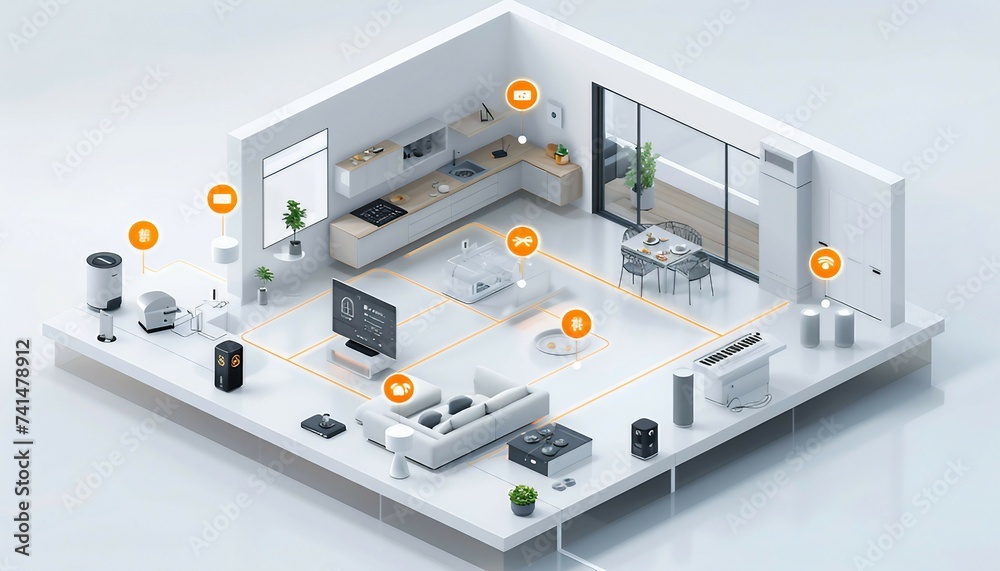

Integrating your tech home devices for seamless control is becoming increasingly important for modern homeowners. The rise of smart home technology has revolutionized how we interact with our homes, offering convenience, enhanced security, and energy efficiency. But the multitude of devices and platforms can be daunting. This article will guide you through the process of seamlessly integrating your smart home devices, covering various integration methods, popular platforms, and common pitfalls. We will explore how to achieve effortless control over your entire smart home ecosystem and provide clear steps towards achieving that goal.
Understanding the Importance of Seamless Control
Defining Seamless Control
Smart home integration aims to create a unified system for controlling various devices in your home. This means you should be able to control everything—from lighting to temperature—through a single interface or app, creating a smooth user experience. Seamless control simplifies your daily interactions with your home and allows you to manage your environment with ease. The challenge lies in the variety of brands and models available, requiring integration platforms to handle the complexities of connecting them.
The Need for Integration
Imagine waking up to a perfectly lit living room, a comfortable temperature, and a brewing pot of coffee. That’s exactly what seamless control in your smart home allows. Smart thermostats, lighting systems, security cameras, and even appliances can all be controlled through a central hub, enabling easy management of energy use and security. This integration eliminates the need to switch between multiple apps and promotes a smooth, streamlined experience. Recent data shows that homeowners who have integrated their smart home devices report significant time savings and increased satisfaction with their homes.
Common Challenges in Integration
Connecting various smart home devices often presents challenges, especially with compatibility issues between brands and models. For instance, an incompatible lighting system or thermostat can disrupt the overall smart home experience and create unnecessary frustration. Another challenge is the complexity of the configuration process. If the integration platform isn’t user-friendly, this can quickly become a significant hurdle for homeowners. Furthermore, choosing the right platform can be overwhelming due to the wide variety of options available.
Exploring Different Integration Methods
Choosing the Right Method
There are several integration methods for connecting your smart home devices. The most popular include using central hubs, cloud-based platforms, and dedicated apps. Each method has its own advantages and disadvantages, so carefully consider your specific needs and preferences.
Central Hub Systems
Central hub systems, like the Apple HomeKit or Amazon Echo, use a central device to manage and control your smart home devices. These hubs often provide a simpler, user-friendly interface. However, compatibility with only certain brands can be a drawback. For example, Apple HomeKit is quite popular but only works well with Apple-branded products and certain third-party devices.
Cloud-Based Platforms
Cloud-based platforms, such as Google Home or SmartThings, offer wider compatibility across a broader range of devices. They use cloud connectivity, allowing for remote control and automation. This advantage makes them appealing to those who prefer a wider variety of products, although the reliability of the cloud connection may cause problems.
Dedicated Apps
Some devices have dedicated apps allowing direct control without the need for a central hub. This approach can provide more direct control but often lacks the overall automation capabilities of central hub systems.
Popular Integration Platforms and Their Features
Overview of Key Platforms
Numerous platforms cater to different needs. Consider platforms like Apple HomeKit, Amazon Alexa, Google Home, and SmartThings. Each platform boasts distinctive features and compatibility that must be matched to your specific smart home device ecosystem.
Features and Capabilities of Key Platforms
Apple HomeKit provides a seamless experience for Apple users, but compatibility is sometimes a concern. Amazon Alexa offers voice control and integrates with other Amazon products, offering a convenient voice-based experience. Google Home, on the other hand, boasts broad compatibility across various brands and offers a user-friendly interface. SmartThings is a more versatile platform, allowing for customization and automation beyond what some other platforms offer. Understanding these differences is vital in choosing the right platform for your needs.
Real-World Examples and Case Studies
Home Automation Success Story
Numerous individuals have benefited from seamless integration. One example involves a homeowner who integrated various devices, including smart lighting, a smart thermostat, and security cameras. This integration not only reduced their energy consumption by 15% but also allowed them to monitor their home from anywhere. This improved their security and peace of mind.
Integration Tips from Expert Homeowners
Expert homeowners share various valuable insights into successful smart home integrations. One of the key takeaways is the importance of meticulous planning. Begin by identifying your home’s needs, and choose integration platforms accordingly. This careful assessment can save time and prevent incompatibility issues down the road.
Conclusion
Common Pitfalls to Avoid
Optimizing Your Smart Home Integration
Advanced Integration Techniques
The Future of Home Automation
Frequently Asked Questions
Q1: What are the common challenges in integrating smart home devices?
A1: A common challenge in integrating smart home devices is compatibility issues between different brands and models. Another frequent problem is the complexity of the setup process, particularly for those who are new to smart home technology. Lack of reliable and intuitive control platforms also proves problematic for some. Additionally, securing these devices from unauthorized access can be a concern for many users.
Q2: How do I choose the right platform for my smart home integration?
A2: The best platform for your smart home integration depends on several factors, including your budget, the types of devices you own, and your technical comfort level. Research available smart home platforms. Consider their user reviews and read comparisons among different options. For starters, you can try free trial versions or use a demo account to experience the platform. Before committing to a platform, thoroughly consider the specific features that are important to you in order to find the perfect fit for your unique home automation needs.
In conclusion, integrating your smart home devices for seamless control offers significant benefits in convenience, energy efficiency, and security. By understanding the various integration methods and choosing the right platforms, you can create a truly intelligent and automated home. Start exploring the options today and experience the future of home automation! Visit our website for more details and to discover how to get started.